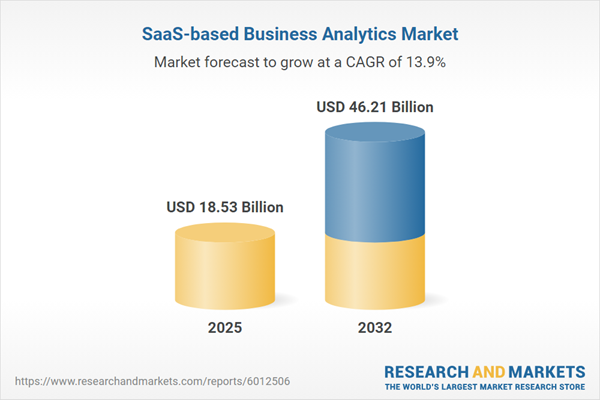Speak directly to the analyst to clarify any post sales queries you may have.
SaaS-based business analytics platforms are enabling organizations to synchronize strategy, enhance operational agility, and accelerate insight-driven decision-making. As enterprise leaders pursue digital transformation, cloud-based analytics offer a flexible, centralized approach to staying effective amid evolving business landscapes.
Market Snapshot: Growth of SaaS-Based Business Analytics
The SaaS-based business analytics market is expanding rapidly as enterprises shift from legacy on-premise systems to advanced cloud-powered solutions. Global revenues are forecast to increase from USD 16.26 billion in 2024 to USD 18.53 billion in 2025, a compound annual growth rate (CAGR) of 13.94%. By 2032, the sector could reach USD 46.21 billion.
This robust growth signals the drive among organizations to adopt scalable, resilient analytics platforms for streamlined digital transformation. Across industries, decision-makers are prioritizing solutions that support unified data access, empower distributed workforces, and inform strategy under varying market conditions.SaaS-Based Business Analytics: Scope & Segmentation
This report details the primary dimensions shaping technology adoption, investment, and deployment decisions for SaaS-based business analytics:
- Architecture Types: Encompasses public multi-tenant, private multi-tenant, and single-tenant architectures to address sector-specific operational or compliance needs.
- Deployment Models: Evaluates both fully cloud-based and on-premise options to support diverse infrastructure strategies and regulatory compliance objectives.
- Organization Size: Covers large enterprises and SMBs, ensuring platforms align with different workflow complexities and business processes.
- Service Offerings: Includes managed services, consulting, and self-service analytics to advance analytical maturity based on unique enterprise requirements.
- Analytics Types: Features dashboard visualizations, scorecards, and predictive analytics utilizing machine learning for deeper planning insight.
- End Users: Applies across finance, IT, marketing, operations, and sales functions, supporting risk assessment and data-informed strategic direction.
- Industry Verticals: Serves stakeholders in financial services, healthcare, government, retail, manufacturing, education, and telecommunications to enhance compliance, user engagement, and productivity goals.
- Geographic Coverage: Analyzes activity in the Americas, Europe, Asia-Pacific, Middle East, and Africa, with an emphasis on trends and standards emerging in China, India, and Japan.
- Technology Integration: Addresses embedded analytics, AI capabilities, and cloud-native solutions driving automation, predictive insights, and scalable global operations.
Key Takeaways for Senior Decision-Makers
- SaaS-based business analytics platforms foster rapid collaboration across departments, equipping organizations to adapt efficiently as market needs change.
- Self-service analytics tools enhance data literacy and empower teams to derive actionable intelligence, supporting decentralized yet aligned decision-making.
- Integrating AI within analytics streamlines operational processes and uncovers new business opportunities, increasing the impact of data beyond traditional reporting.
- Strong data governance frameworks, including secure access controls and encryption, help enterprises safeguard sensitive data and remain compliant with key regulations.
- Flexible subscription and deployment options allow organizations to adjust their analytics investments in line with changing business goals or environments.
- Collaboration with established vendors and regional experts accelerates implementation and ensures alignment with local operational practices.
Tariff Impact and Cost Dynamics in SaaS Business Analytics
Recent updates to U.S. tariffs are affecting cost structures for SaaS-based business analytics by influencing hardware procurement and datacenter operation expenses. Vendors are mitigating these impacts by improving supply chain efficiency and forming local collaborations to minimize pricing volatility. Organizations increasingly consider hybrid deployment strategies to balance operational continuity and cost management, prompting adjustments to procurement and risk strategies in response to shifting regulatory landscapes.
Methodology & Data Sources
The findings in this report are grounded in interviews with senior business and technology leaders, peer-reviewed research, industry-standard benchmarks, and direct practitioner input. Employing a triangulated methodology strengthens reliability and executive relevance for market analysis.
SaaS-Based Business Analytics: Why This Report Matters
- Aligns analytics investments with enterprise technology priorities, compliance standards, and evolving regional market requirements.
- Delivers practical frameworks to simplify vendor selection and streamline analytics deployment, supporting measurable operational improvements.
- Equips decision-makers with the tools needed to drive value from data resources and reinforce strong data stewardship within the organization.
Conclusion
SaaS-based business analytics help organizations anticipate and respond to operational change. Their flexible architectures support ongoing evolution, strengthening preparedness in competitive, dynamic markets.
Additional Product Information:
- Purchase of this report includes 1 year online access with quarterly updates.
- This report can be updated on request. Please contact our Customer Experience team using the Ask a Question widget on our website.
Table of Contents
3. Executive Summary
4. Market Overview
7. Cumulative Impact of Artificial Intelligence 2025
Companies Mentioned
The companies profiled in this SaaS-based Business Analytics market report include:- Microsoft Corporation
- Salesforce, Inc.
- SAP SE
- Oracle Corporation
- SAS Institute Inc.
- IBM Corporation
- QlikTech International AB
- Google LLC
- TIBCO Software Inc.
- MicroStrategy Incorporated
Table Information
| Report Attribute | Details |
|---|---|
| No. of Pages | 195 |
| Published | October 2025 |
| Forecast Period | 2025 - 2032 |
| Estimated Market Value ( USD | $ 18.53 Billion |
| Forecasted Market Value ( USD | $ 46.21 Billion |
| Compound Annual Growth Rate | 13.9% |
| Regions Covered | Global |
| No. of Companies Mentioned | 11 |









